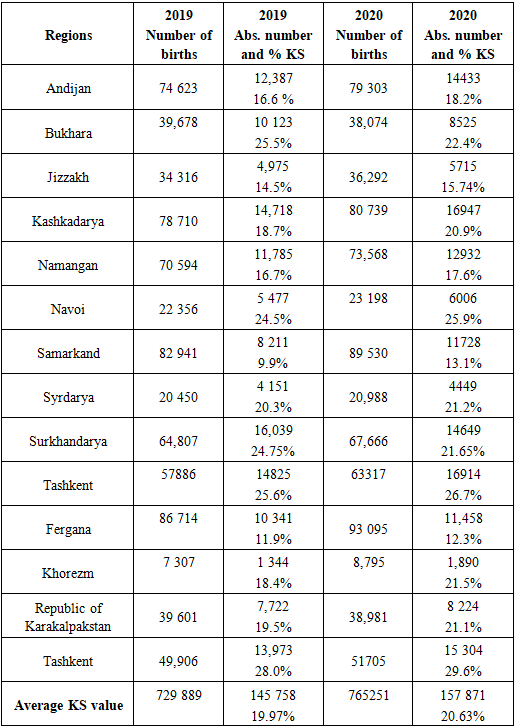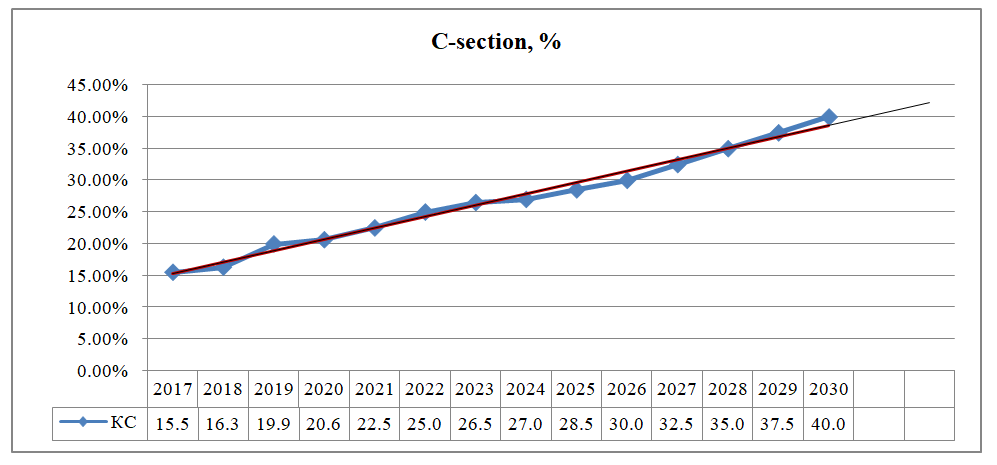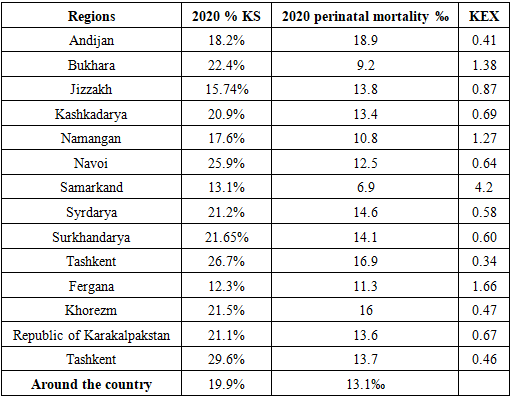Asadov Doniyor Alisherovich
Republican Perinatal Center, Uzbekistan, Tashkent, Uzbekistan
Correspondence to: Asadov Doniyor Alisherovich, Republican Perinatal Center, Uzbekistan, Tashkent, Uzbekistan.
Copyright © 2024 The Author(s). Published by Scientific & Academic Publishing.
This work is licensed under the Creative Commons Attribution International License (CC BY).
http://creativecommons.org/licenses/by/4.0/

Abstract
The article presents and examines the relationship between the perinatal mortality rate and the frequency of cesarean sections in the hospital. The research material is the birth histories of women delivered by cesarean section, annual reports for 2017, 2018, 2019. The research method was a retrospective analysis of birth histories. Results. A decrease in the frequency of cesarean sections and an increase in the ratio of natural births to births by cesarean section over 3 years were established. The study of the structure of indications for cesarean section made it possible to identify reserves for reducing the frequency of cesarean sections due to proper preparation for pregnancy of women with a uterine scar and proper management of pregnancy in women with a breech presentation of the fetus. It has been shown that high cesarean section rates do not reduce perinatal mortality. Conclusion. Regular analysis of caesarean section cases using modern technologies is necessary.
Keywords:
Caesarean section rate, Perinatal mortality, Effectiveness rate
Cite this paper: Asadov Doniyor Alisherovich, Rate of Cesarean Section, Effectiveness of Abdominal Delivery in Reducing Perinatal Mortality, American Journal of Medicine and Medical Sciences, Vol. 4 No. 2, 2024, pp. 316-320. doi: 10.5923/j.ajmms.20241402.33.
1. Introduction
In modern obstetrics, caesarean section is the most common obstetric operation. There are a number of objective reasons for this phenomenon. In recent years, there has been a trend towards an increase in the number of women whose first birth occurs over the age of 30, which is often combined with a burdened gynecological history or recurrent miscarriage, as well as the presence of various somatic diseases that cause a pathological course of pregnancy [4,5,10]. An important contribution is made by the introduction of assisted reproductive technologies into practice, the increase in the number of women with a uterine scar, the abandonment of obstetric forceps in case of complications during childbirth, and the expansion of indications for the fetus [1,3,7,11]. In this regard, caesarean section has acquired socio-economic significance in recent years. This is due to the increase in the frequency of cesarean sections, which is not a natural delivery method.Abdominal delivery aims to follow the main principle of perinatal medicine - maintaining the health of the mother and gentle delivery for the fetus. However, once the caesarean section rate reaches 15%, the reduction in perinatal mortality stops. In addition, cesarean section is associated with an increased incidence of complications during the operation and in the postoperative period, as well as during subsequent operations [2,8,12,14]. Not in all cases, an increase in the frequency of cesarean sections reduces perinatal mortality. Perinatal morbidity and mortality rates in some regions exceeded the national average, and the caesarean section rate in these regions was 30%. WHO studies have shown that when the share of cesarean section in the structure of all types of delivery reaches 10%-15%, the maternal and perinatal mortality rate does not decrease [6,9,13,15].Purpose of the study: To study the relationship between perinatal mortality and the frequency of cesarean sections in maternity hospitals.
2. Material and Methods
Of research the object of the study was a maternity hospital in Uzbekistan. The material for the study was the birth histories of women admitted to the Regional Perinatal Center in 2019 and their newborns delivered by cesarean section, annual reports in this hospital for 2017-2019. A retrospective analysis of this documentation and statistical processing of the data obtained was carried out. Statistical analyzes included calculation of rates (absolute number of caesarean sections divided by total number of deliveries and multiplied by 100). Calculation of the perinatal mortality rate is the number of perinatal deaths per 1000 births. The effectiveness of cesarean section in relation to perinatal outcomes was assessed by calculating the effectiveness coefficient using the formula: cesarean section effectiveness ratio = cesarean section rate in the region × perinatal mortality in the region / cesarean section rate in the given institution × perinatal mortality in the given institution.
3. Results and Its Discussion
In the institution studied, 691 births were registered in 2017, in 2018 – 729,889 births, in 2019 – 765,251 births. In our country, the optimal value of cesarean section is exceeded in the general population. In terms of CS frequency, the leaders are the city of Tashkent, Bukhara, Navoi, Tashkent, Khorezm, and Kashkadarya regions; in these regions, the CS frequency is higher than in the country. Regions with optimal CS values are Fergana, Samarkand, Jizzakh, Namangan regions. As can be seen from the table, the frequency of cesarean sections over the three years followed tended to decrease, despite the increase in the number of births.Table 1. Cesarean section frequency by regions of Uzbekistan
 |
| |
|
An important goal of modern obstetrics is to reduce the frequency of cesarean sections by increasing the frequency of vaginal births of women with a uterine scar [2]. One indicator of the quality of existing policies to reduce the rate of cesarean sections in institutions is the ratio of the number of vaginal births to the number of cesarean sections. We calculated the forecast for the level of abdominal births in Uzbekistan based on the time series of CS rates. Evaluating the data obtained according to the mathematical forecast model, it can be assumed that if the trends in the dynamic series continue, the probable forecast value will increase annually and by 2030 will reach 40% of abdominal births per year in the Republic of Uzbekistan, which is 2.6 times more compared to 2017 .This ratio is typical for maternity hospitals, where there is a concentration of women with severe obstetric complications and somatic pathology. Indications for cesarean section are presented in the table. | Diagram 1. Cesarean section rate forecast for 2022-2030. in Uzbekistan |
As can be seen from the data presented in the table, over the years, the structure and share of indications for cesarean section have remained virtually unchanged. The most common indication for cesarean section in all years was a uterine scar in combination with complications, in most cases due to failure of the uterine scar (30.9%, 32.8%, 44.6%). A scar on the uterus is an indication for a repeat cesarean section in almost every 3rd woman. Breech presentation, according to the clinical protocol used in our country, when combined with conditions such as uterine development anomalies, uterine scar, large fetus, fetal hypoxia, post-term pregnancy, complicated reproductive history, certain somatic pathology of the mother - are an indication for cesarean operation section. In the institution we studied, the share of breech presentation in the structure of indications for surgery was 5%-5.5%. The indication for cesarean section “premature placental abruption” was determined in 5.9% of cases in 2019 and in 8.1% of cases in 2017 among all operations. The proportion of obstructive births due to incorrect insertion of the head (asynclitic, frontal, posterior facial view, high straight position of the sagittal suture, low transverse position of the sagittal suture), clinically narrow pelvis in 2017 and 2018 was approximately the same and amounted to 6.2% and 6.1%. And in 2019 it decreased slightly to 4.9%. Severe preeclampsia in combination with other obstetric complications or complications of the most severe preeclampsia was an indication for cesarean section in approximately 6% of cases annually. Considering that abdominal delivery aims to follow the main principle of perinatal medicine - preserving the health of the mother and gentle delivery for the fetus, we considered it appropriate to trace the dynamics of perinatal mortality in the studied institution over the years.To determine whether there are unjustifiably high levels of operative delivery against the background of high rates of perinatal mortality (PM), in order to determine the validity of a particular frequency of CS in an institution or region, we calculated the cesarean section efficiency ratio (CEC).Basic formula for calculating KEX:KEKS = CS of the base region × PS of the base region × 10 / CS of the studied region × SS of the studied region.The effectiveness coefficient of the CS was assessed on the scale:2 or more–very high; 1.5-1.9 – high; 1.0-1.4 – average;0.5-0.9 – low; less than 0.5 – very low. The KEKS value equal to 1.0 is a kind of boundary: if the coefficient is greater than 1.0, this is good, and the higher, the better; if less, it is bad.We assessed the CFR in Uzbekistan using the optimal CFR percentage of 15% (proposed by WHO) and perinatal mortality of 10‰ as the base level. The KER for 2018 was 0.49, in 2019 - 0.47, in 2020 - 0.42, these data show that in our country the effectiveness of CS in reducing perinatal mortality is low. We assessed the effectiveness of the CS for 2020 by region of the country; the results are presented in Table 2.Table 2. Efficiency of caesarean section in regions of the country
 |
| |
|
We determined that the effectiveness of the CS in reducing PS is very high in the Samarkand and Fergana regions, average in the Bukhara, Namangan regions, low in the Republic of Karakalpakstan, Kashkadarya, Syrdarya, Surkhandarya, Navoi, Jizzakh regions, very low in the Andijan, Tashkent regions and in Tashkent. The calculation showed that if the share of CS operations in the country increases by only 1% compared to 2020, then this will be an additional 1,578 operations per year, which will lead to the allocation of more than 5.5 billion soums (5,658,825,797.7 soums) in year. Also, a reduction of just 1% in CS operations across the country will lead to savings of more than 5.5 billion soums per year. According to WHO (2015), a total of 6.2 million CS are performed worldwide without medical indications annually, the cost of which is estimated at approximately 2.32 billion US dollars. When studying the indications for CS, we determined that the indications from the mother were reliable in 5.5. times more likely to be an indication for CS than fetal indications (p=0.000004). Among the indications from the mother, obstetric indications (uterine scar, PONRP, pelvic-cephalic disproportion, abnormal fetal position, preeclampsia, weakness of labor, uniformly narrowed pelvis, etc.) were significantly more often (71.9% and 67.2%) indications to CS (p=0.000004 and p=0.000007) than maternal extragenital somatic diseases (9.79% and 11.6%). At the same time, we identified a significant increase in indications for extragenital diseases in 2018 than in 2017 (p = 0.004). When compared with the previous year, fetal readings also showed a statistically significant upward trend (p=0.000395).
4. Conclusions
Thus, the frequency of cesarean sections in the Republic of Uzbekistan is steadily increasing. In 2017, 107,156 CS operations were performed, which was 15.5%; in 2018, 120,006 CS operations were performed, which was 16.3%; in 2018, 145,758 CS operations were performed, which was 19.97%, in 2020, 157,871 CS operations were performed, which amounted to 20.63%. In just 4 years (2017-2020), more than half a million (530,791) CS operations were performed. An assessment of the effectiveness of the CS in the regions of the country for 2020, in comparison with country data for 2020, showed that the effectiveness of the CS in reducing PS is very high in the Samarkand and Fergana regions, average in the Bukhara, Namangan regions, low in the Republic of Karakalpakstan, Kashkadarya, Syrdarya, Surkhandarya, Navoi, Jizzakh regions, very low in Andijan, Tashkent regions and throughout the city of Tashkent. When studying the indications for CS in perinatal centers, we determined that the indications from the mother were reliable at 5.5. times more likely to be an indication for CS than fetal indications (p=0.000004). Among the indications from the mother, obstetric indications (uterine scar, PONRP, pelvic-cephalic disproportion, abnormal fetal position, preeclampsia, weakness of labor, uniformly narrowed pelvis, etc.) were significantly more often (71.9% and 67.2%) indications to CS (p=0.000004 and p=0.000007) than (extragenital) somatic diseases of the mother (9.79% and 11.6%). At the same time, we identified a significant increase in indications for CS for extragenital diseases in 2018 compared to 2017 (p = 0.004). When compared with the previous year, fetal readings also showed a statistically significant upward trend (p=0.000395).
References
| [1] | Ailamazyan E.K., Serov V.N., Radzinsky V.E., Savelyeva G.M. Obstetrics. National leadership. - M.: GEOTAR Media, 2015. - 608 p. |
| [2] | Akhmedov F.K. biochemical markers of preeclampsia development and criteria for early diagnosis- Art of Medicine. International Medical Scientific Journal, 2022.10.5281/zenodo.6635595. |
| [3] | F.K. Akhmedov. The role of interleukin 10 in the development of preeclampsia: diagnosis and prognosis- British Medical Journal, 2022 Volume-2, No 410.5281/zenodo.6912557. |
| [4] | F.K. Akhmedov., M.N. Negmatullaeva. The significance of genetic factors and new aspects in predicting preeclampsia (overview)- Thematic journal of microbiology, 2021.10.5281/zenodo.5081885. |
| [5] | Akhmedov F. K., Negmatullaeva M. N., Kurbanova Z. S. Modern views on the problem of preeclampsia // A new day in medicine. – 2018. – Т. 1. – №. 21. – С. 180-185. |
| [6] | Akhmedov F. K., Negmatullaeva M. N. Features of the state of central hemodynamics and hemostasis in pregnant women with preeclampsia of varying degrees and severity // New Day of Medicine. – 2020. – №. 1. – С. 29. |
| [7] | Akhmedov F.K., Negmatullaeva M.N., Avakov V.E. Features of renal blood flow and dynamics of uric acid concentration in women with pregnancy complicated by preeclampsia // Clinical nephrology. - 2018. - N. 1. - P. 38-40. |
| [8] | Guryev D.L., Okhapkin M.B., Guryeva M.S., Kabanov I.V. et al. Reducing the frequency of cesarean sections and perinatal losses in a level 3A hospital using the Robson classification // Doctor. Ru.- 2019.- No. 4 (159).- P. 8–13. |
| [9] | Orlova V.S., Kalashnikova I.V., Bulgakov E.V. and others. Modern practice of cesarean section abroad // Scientific Gazette. - 2015.- No. 18(161), Issue. 23. - pp. 12-18. |
| [10] | Radzinsky V.E., Logutova L.S., Krasnopolsky V.I. C-section. Problems of abdominal obstetrics /ed. IN AND. Krasnopolsky. - M.: Special Publishing House of Medical Books (SIMK), 2018. - 224 p. |
| [11] | Rymashevsky A.N., NabokaYu.L., Potapova M.V. Modern problems of abdominal delivery // Medical Bulletin of the South of Russia. - 2013. - No. 2. - P. 20-24. |
| [12] | Savvina N.V., Novgorodova U.R. Caesarean section and ways to reduce reproductive losses // Problems of social hygiene, health care and history of medicine. - 2015. - No. 23 (4). - P. 24-26. 7. Stepanova R.N. The problem of delivery of women after a previous cesarean section // Ulyanovsk Medical and Biological Journal. - 2018. - No. 3. - P. 19-27. |
| [13] | Boatin A., Schlotheuber A., Betran AP Within country inequalities in cesarean section rates: observational study of 72 low and middle income countries // Obstet. Gynecol. Surv.- 2018.-Vol. 73 (6) .- R. 333–334. REFERENCES 1. Aylamazyan EK, Serov VN, Radzinskiy VE, Saveleva GM Akusherstvo. |
| [14] | Savvina NV, Novgorodova UR Kesarevosechenieiputisnizheniyareproduktivnykhpoter [The cesarean section and ways of decreasing of reproductive losses]. Problemy Sotsialnoy Gigieny, ZdravookhraneniyaiIstorii Meditsiny. [Problems of Social Hygiene, Health Care and Medical History]. 2015; 23 (4): 24-26. |
| [15] | Stepanova RN Problemarodorazresheniyazhenshchinposlepredshestvuyushchegokesarevasecheniya [Problems of delivery after cesarean section]. Ulyanovskiy Mediko-biologicheskiy Zhurnal. [Ulyanovsk Medical and Biological Journal]. 2018; 3: 19-27. |



 Abstract
Abstract Reference
Reference Full-Text PDF
Full-Text PDF Full-text HTML
Full-text HTML
